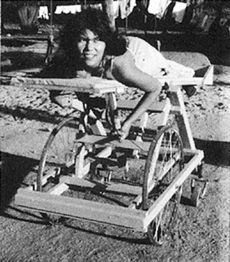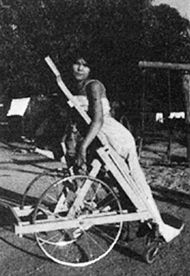Hesperian Health Guides
Keeping Active

Many of the complications of spinal cord injury happen because the person spends a lot of time just lying and sitting. To keep healthy, the body needs to keep active. Lack of movement and activity causes poor flow of the blood. This can lead to pressure sores, swollen feet, painful or dangerous blood clots (thrombosis) especially in the legs, increasing weakness of bones (osteoporosis) with risk of breaking them, stones in the bladder or kidneys, increased risk of urinary infections, and general physical weakness and poor health.
| It is important—both for the body and mind—that people with spinal cord injuries keep physically active. Let your child do as much for herself as she can: pushing her own wheelchair, bathing, transferring, washing clothes, cleaning house, and helping with work. |  |
 |
Active games and sports can also be encouraged. Swimming, basketball, and archery can be done well with upper body use only. People with quadriplegia can become skillful with bow and arrow by using a straight-arm splint and a hook, fastened to the hand, to pull the string. |
 |
Note: Archery may also help correct spinal curve. The arm that pulls the string should be on the side with bulge in the back.
To keep leg bones growing well and to prevent them from becoming weak and breaking easily, even children who may always be wheelchair riders should stand for a while every day. Standing also helps the child’s bowels move more often.
 |
This can be done by strapping the child to a ’standing board’, or by making some kind of a standing frame. |  |
This standing frame was invented by a young person with paraplegia and his father. The boy uses the spasticity in his legs to stand. When the muscles tire he hangs and sits on the padded poles. |
 |
This design for a standing wheel-bed allows a spinal cord injured child with pressure sores on her butt to actively move about. The child can adjust it while on it, from a flat-lying position to a near-standing position. It can be made out of wood or metal. |
 |
People with spinal cord injuries as leaders
People with spinal cord injuries in various countries are now taking the lead in making new lives for themselves and in getting their communities to recognize their abilities. Examples of 2 programs run primarily by people with spinal cord injuries are included in Chapter 55. These are the Organization of Disabled Revolutionaries in Nicaragua and the Centre for the Rehabilitation of the Paralysed in Bangladesh. Members of these and many similar organizations would be happy to share ideas and suggestions with any group of people with disabilities interested in organizing their own program or shop.


